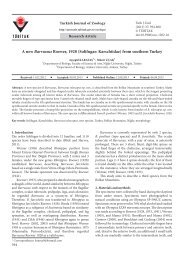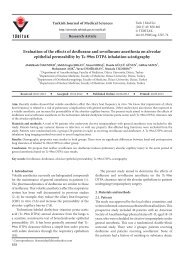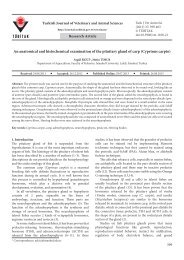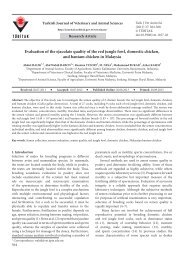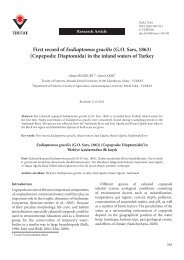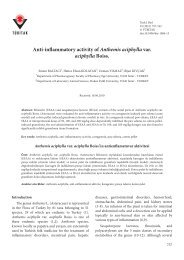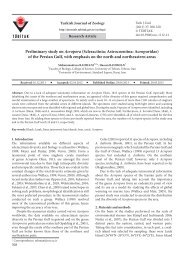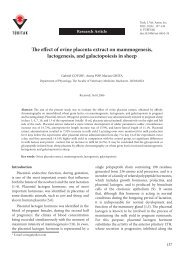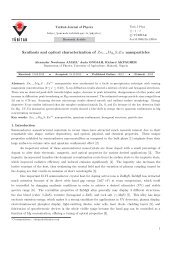Mitigation of SSR and LFO with a TCSC based-conventional ...
Mitigation of SSR and LFO with a TCSC based-conventional ...
Mitigation of SSR and LFO with a TCSC based-conventional ...
Create successful ePaper yourself
Turn your PDF publications into a flip-book with our unique Google optimized e-Paper software.
Turkish Journal <strong>of</strong> Electrical Engineering & Computer Sciences<br />
http://journals.tubitak.gov.tr/elektrik/<br />
Research Article<br />
Turk J Elec Eng & Comp Sci<br />
():1–16<br />
c○ TÜB˙ ITAK<br />
doi:10.3906/elk-1112-81<br />
<strong>Mitigation</strong> <strong>of</strong> <strong>SSR</strong> <strong>and</strong> <strong>LFO</strong> <strong>with</strong> a <strong>TCSC</strong> <strong>based</strong>-<strong>conventional</strong> damping controller<br />
optimized by the PSO algorithm <strong>and</strong> a fuzzy logic controller<br />
Hasan GHAHRAMANI, ∗ Akbar LAK, Murtaza FARSADI, Hossein HOSSEINI<br />
Department <strong>of</strong> Electrical Engineering, University <strong>of</strong> Urmia, Urmia, Iran<br />
Received: 29.12.2011 • Accepted: 19.03.2012 • Published Online: ..2013 • Printed: ..2013<br />
Abstract:The subsynchronous resonance (<strong>SSR</strong>) phenomenon may occur when a steam turbine-generator is connected to<br />
a long transmission line <strong>with</strong> series compensation. Flexible AC transmission systems (FACTS) devices are widely applied<br />
to damp the <strong>SSR</strong> <strong>and</strong> low-frequency oscillation (<strong>LFO</strong>). A thyristor-controlled series capacitor (<strong>TCSC</strong>) is a commercially<br />
available FACTS device that was developed for damping the <strong>SSR</strong> <strong>and</strong> <strong>LFO</strong>. In this paper, 2 control methods for damping<br />
the <strong>SSR</strong> <strong>and</strong> <strong>LFO</strong> are added to the <strong>TCSC</strong> main controller in order to demonstrate that the <strong>SSR</strong> damping capability <strong>of</strong><br />
the <strong>TCSC</strong> can be enhanced by proper modulation <strong>of</strong> the firing angle. The control methods are presented, namely the<br />
<strong>conventional</strong> damping controller (CDC) <strong>and</strong> fuzzy logic damping controller (FLDC). The particle swarm optimization<br />
(PSO) algorithm is used for searching optimized parameters <strong>of</strong> the CDC. Fast Fourier transform is carried out in order<br />
to evaluate the effect <strong>of</strong> the <strong>TCSC</strong>-<strong>based</strong> FLDC in damping the <strong>SSR</strong> <strong>and</strong> <strong>LFO</strong>. The study system was adopted from the<br />
IEEE second benchmark model by altering a part <strong>of</strong> the fixed series capacitor to the <strong>TCSC</strong>. The MATLAB/Simulink<br />
was used to verify the effectiveness <strong>of</strong> each control method. The simulation results show that the FLDC has an excellent<br />
ability in damping the <strong>SSR</strong> <strong>and</strong> <strong>LFO</strong> in the power system toward the CDC-optimized PSO algorithm.<br />
Key words: Subsynchronous resonance, low-frequency oscillation, thyristor-controlled series capacitor, particle swarm<br />
optimization, fuzzy logic controller<br />
1. Introduction<br />
Series capacitive compensation in AC transmission lines provides several advantages; for example, the increased<br />
power transfer capability <strong>of</strong> long transmission lines <strong>and</strong> improved transient stability <strong>of</strong> power systems. This<br />
is due to the partial compensation <strong>of</strong> the reactance <strong>of</strong> the power networks. However, capacitors in series<br />
<strong>with</strong> transmission lines can also lead to subsynchronous resonance (<strong>SSR</strong>) problems. When this methodology<br />
is implemented together <strong>with</strong> a steam turbine-generator, it can cause the <strong>SSR</strong> occurrence [1–3]. The flexible<br />
AC transmission systems (FACTS) controllers, for instance, the static var compensator, static synchronous<br />
series compensator, unified power flow controller, <strong>and</strong> gate-controlled series capacitor, have been implemented<br />
to mitigate the <strong>SSR</strong> in power networks [4–7]. Among the FACTS devices for transient stability improvement,<br />
the thyristor-controlled series capacitor (<strong>TCSC</strong>) is the most adaptable [8,9]. It can change its obvious reactance<br />
smoothly <strong>and</strong> quickly [10,11]. The <strong>TCSC</strong> has a great application <strong>and</strong> ability <strong>of</strong> exactly adjusting the power<br />
flow on a transmission line, alleviating interarea power oscillations [12], damping the <strong>SSR</strong>, <strong>and</strong> enhancing the<br />
transient stability [13].<br />
∗ Correspondence: hesen.qehremani@gmail.com<br />
1
GHAHRAMANI et al./Turk J Elec Eng & Comp Sci<br />
The alleviation effect <strong>of</strong> the <strong>TCSC</strong> has the following characteristics [14]:<br />
• The <strong>TCSC</strong> for the alleviation <strong>of</strong> power oscillations is more effective than the shunt FACTS devices.<br />
• The <strong>TCSC</strong> becomes more efficient at controlling power oscillations at higher levels <strong>of</strong> power exchange.<br />
• The situation <strong>of</strong> a <strong>TCSC</strong> on an intertie does not influence the alleviation result.<br />
• The alleviation result is not sensitive to the load features.<br />
• The local modes are not excited when a <strong>TCSC</strong> is planned to alleviate the interarea modes.<br />
This work shows a detailed analysis <strong>of</strong> the effect <strong>of</strong> different <strong>TCSC</strong> control techniques on the <strong>SSR</strong> <strong>and</strong> lowfrequency<br />
oscillation (<strong>LFO</strong>) alleviation. The 2 techniques that are used in this paper are explained in the<br />
following:<br />
In this paper, output feedback <strong>of</strong> the <strong>conventional</strong> damping controller (CDC) optimized by particle swarm<br />
optimization (PSO) is designed for <strong>TCSC</strong> in order to damp the <strong>SSR</strong> <strong>and</strong> <strong>LFO</strong>.<br />
The fuzzy logic damping controller (FLDC) has been one <strong>of</strong> the popular controllers among the research<br />
that has been proposed in power system applications [15,16] such as <strong>SSR</strong> <strong>and</strong> <strong>LFO</strong> alleviation. The benefits <strong>of</strong><br />
the FLDC over the CDC are that it does not require an exact mathematical model; it can cope <strong>with</strong> nonlinearity<br />
<strong>and</strong> may be more robust than the optimized CDC [15].<br />
The paper is organized as follows. In Section 2, the subsynchronous resonance phenomenon is explained<br />
briefly. The power system structure for the <strong>SSR</strong> study is clarified in Section 3. In Section 4, the fast Fourier<br />
transform (FFT) analysis <strong>of</strong> the generator rotor speed is demonstrated. The structure <strong>of</strong> the <strong>TCSC</strong> is briefly<br />
presented in Section 5. In Section 6, the PSO technique is described. The design <strong>of</strong> the CDC is given <strong>and</strong><br />
is briefly explained in Section 7. In Section 8, the FLDC design is presented. The simulation results <strong>with</strong> a<br />
detailed comparison between the 2 proposed controllers, the CDC optimized <strong>with</strong> the PSO algorithm <strong>and</strong> a<br />
fuzzy logic controller (FLC), in 2 cases are included in Section 9. Finally, in Section 10, the results obtained<br />
from the previous sections are summarized <strong>and</strong> conclusions are drawn.<br />
2. Subsynchronous resonance<br />
Due to the destructive effects <strong>of</strong> the <strong>SSR</strong> phenomenon, this phenomenon should be introduced <strong>and</strong> discussed.<br />
In this paper, 2 novel auxiliary controllers, the FLDC <strong>and</strong> adaptive neuro fuzzy inference system controllers,<br />
for damping the <strong>SSR</strong> <strong>and</strong> <strong>LFO</strong> are added to the <strong>TCSC</strong> main controller. Therefore, in this part, the <strong>SSR</strong><br />
phenomenon will be introduced <strong>and</strong> analyzed.<br />
Generally, <strong>SSR</strong> occurs in series-compensated transmission lines [1]. The series compensation <strong>of</strong> a transmission<br />
line can be caused by the excitation <strong>of</strong> the oscillatory modes <strong>of</strong> the rotor shaft at a subsynchronous<br />
frequency [2]. A series capacitor-compensated power system has a subsynchronous natural frequency (fe ),<br />
which is given by:<br />
<br />
XC<br />
fe = fo<br />
XL<br />
(1)<br />
where XC is the reactance <strong>of</strong> series capacitor, XL is the reactance <strong>of</strong> a compensated line, <strong>and</strong> fo is the<br />
synchronous frequency <strong>of</strong> the power system in Hz. At this subsynchronous natural frequency, these oscillatory<br />
modes result in rotor torques <strong>and</strong> currents at the complementary frequency, fr as: fr = fo − fe . Hence, if fr<br />
2
GHAHRAMANI et al./Turk J Elec Eng & Comp Sci<br />
is close to one <strong>of</strong> the torsional frequencies <strong>of</strong> the rotor shaft, the torsional oscillations will be excited <strong>and</strong> this<br />
condition will result in an unfavorable phenomena, namely the <strong>SSR</strong> [3]. Generally, the <strong>SSR</strong> is divided into 2<br />
major parts: self-excitation, which is named by steady-state <strong>SSR</strong>, <strong>and</strong> the second is named transient torque or<br />
transient <strong>SSR</strong>. Self-excitation is separated into 2 major parts: the first is the induction generator effect (IGE),<br />
<strong>and</strong> the second is torsional interaction (TI). The IGE is improbable in a series compensated power system.<br />
However, the TI <strong>and</strong> transient <strong>SSR</strong> mostly occur in series compensated power systems [17,18]. Because the<br />
main aim <strong>of</strong> this paper is to suppress the <strong>SSR</strong> in a series-compensated transmission line, the proposed controller<br />
is designed to solve major <strong>SSR</strong> problems, transient torque, <strong>and</strong> TI.<br />
3. Power system study model<br />
To study the effects <strong>of</strong> the <strong>SSR</strong> phenomenon <strong>and</strong> its mitigation, the <strong>TCSC</strong> should be supplemented <strong>with</strong> auxiliary<br />
controllers that will be added to its main controller. To achieve this goal, a system is needed to investigate<br />
the effects <strong>of</strong> <strong>SSR</strong> on it. In this part, the system under study, the IEEE second benchmark model (ISBM), is<br />
introduced, <strong>and</strong> briefly explained for the mentioned goal.<br />
For the analysis investigated in this study, the ISBM is used [19]. The system is composed <strong>of</strong> a synchronous<br />
generator supplying power to an infinite bus via 2 parallel transmission lines; it is a single machine infinite bus<br />
power network that has 2 transmission lines <strong>and</strong> 1 <strong>of</strong> them is compensated by a series capacitor accompanying<br />
the <strong>TCSC</strong> that is shown in Figure 1. In this model, a 600 MVA synchronous generator is attached to an infinite<br />
bus, <strong>and</strong> the rated line voltage is 500 KV, while the rated frequency is 60 Hz. The shaft system consists <strong>of</strong> 4<br />
masses: the generator (G) <strong>and</strong> rotating exciter (EX), a high-pressure (HP) turbine, <strong>and</strong> a low-pressure (LP)<br />
turbine. The transmission line is illustrated by a resistance, a reactance, a series fixed capacitive compensation<br />
(Xfc), <strong>and</strong> the <strong>TCSC</strong> <strong>with</strong> an equivalent reactance (X<strong>TCSC</strong>(α)). The complete mechanical <strong>and</strong> electrical data<br />
for the study system are displayed in [19].<br />
Turbines<br />
HP<br />
LP<br />
Error a mplifie r<br />
PIcontroller<br />
_<br />
+<br />
Ge Ex<br />
G<br />
Generator<br />
Controlle ra ble<br />
phase shifter<br />
Synchronous<br />
timing (PLL)<br />
circuit<br />
Fault<br />
Bus1<br />
Angle<br />
correction<br />
circuits<br />
i<br />
+<br />
Z L1<br />
+<br />
L<br />
Gate pulse<br />
generator<br />
Z<br />
C<br />
L2<br />
T2<br />
T1<br />
Auxiliary Damping<br />
Controller<br />
X c<br />
<strong>TCSC</strong><br />
Bus2<br />
Figure 1. The ISBM combined <strong>with</strong> a <strong>TCSC</strong> for <strong>SSR</strong> analysis.<br />
Z system<br />
Infinite<br />
Bus<br />
4. Fast Fourier transform analysis<br />
FFT is one <strong>of</strong> the most appropriate approaches for achieving the oscillatory modes <strong>of</strong> the system, which is used<br />
in this study to investigate the inherent modes in the ISBM. It should be noted that the <strong>TCSC</strong> has no inherent<br />
ability for damping the <strong>SSR</strong>.<br />
3
GHAHRAMANI et al./Turk J Elec Eng & Comp Sci<br />
For evaluating the dynamic features <strong>of</strong> the power system, the FFT analysis is achieved using an M-file<br />
in the MATLAB program, which is shown in Figure 2. The <strong>with</strong>out damping factor <strong>of</strong> the <strong>SSR</strong> modes <strong>of</strong> the<br />
generator rotor shaft, as a function <strong>of</strong> the percentage <strong>of</strong> compensation, which means that the ratio <strong>of</strong> the series<br />
capacitive reactance to the line reactance ((XC/XL)× 100) is shown, is fixed at 55% ((Xfc /XL) = 0.37 <strong>and</strong><br />
(X <strong>TCSC</strong>(α)/XL ) = 0.18) to excite the oscillatory mode <strong>of</strong> the generator rotor shaft. The FFT analysis reveals<br />
that 3 modes exist in the generator rotor speed, <strong>of</strong> which 2 <strong>of</strong> the modes, 25 Hz <strong>and</strong> 32.5 Hz, are the oscillatory<br />
modes <strong>of</strong> the generator rotor shaft, <strong>and</strong> the third mode, 1.5 Hz, is the low frequency oscillation. The conqueror<br />
mode, which has a subsynchronous frequency, is 25 Hz.<br />
Mag (% <strong>of</strong> fundamental)<br />
400<br />
350<br />
300<br />
250<br />
200<br />
150<br />
100<br />
50<br />
X: 1.5<br />
Y: 22.92<br />
X: 25<br />
Y: 378.3<br />
X: 32.5<br />
Y: 22.67<br />
0<br />
0 10 20 30<br />
Frequency (Hz)<br />
40 50 60<br />
Figure 2. FFT analysis on the generator rotor shaft for verifying the conqueror mode.<br />
To confirm how undesirable this dominant mode is, the FFT analysis <strong>of</strong> the generator rotor speed is<br />
presented at 1–9 s, <strong>with</strong> a time division <strong>of</strong> 2 s. The results acquired for the FFT analysis are displayed in<br />
Figure 3.<br />
Mag (% <strong>of</strong> fundamental)<br />
Mag (% <strong>of</strong> fundamental)<br />
1000<br />
500<br />
1000<br />
0<br />
0 20 40 60<br />
Frequency (Hz)<br />
500<br />
0<br />
0 20 40 60<br />
Frequency (Hz)<br />
Mag (% <strong>of</strong> fundamental)<br />
Mag (% <strong>of</strong> fundamental)<br />
1000<br />
500<br />
1000<br />
0<br />
0 20 40 60<br />
Frequency (Hz)<br />
500<br />
0<br />
0 20 40 60<br />
Frequency (Hz)<br />
Figure 3. FFT analyses on ω <strong>of</strong> the generator rotor speed, <strong>with</strong>out a damping controller.<br />
Referring to Figure 3, it can be seen that as the time advances the conqueror mode component increases<br />
considerably. Hence, if this continues to intensify, the rotor shaft can seriously damage the mechanical shaft<br />
system; thus, there should be a controller in order to alleviation this contrary oscillatory component from the<br />
rotor shaft in order to protect the power system.<br />
4
GHAHRAMANI et al./Turk J Elec Eng & Comp Sci<br />
5. Structure <strong>of</strong> the <strong>TCSC</strong><br />
As mentioned, the <strong>TCSC</strong> is one <strong>of</strong> the FACTS devices that are used in this study to mitigate the <strong>SSR</strong>. Therefore,<br />
the structure <strong>of</strong> the <strong>TCSC</strong> is introduced in this section. The <strong>TCSC</strong> is one <strong>of</strong> the most widely utilized FACTS<br />
devices in power systems. It can adjust the impedance smoothly in an extensive range by adjusting the firing<br />
angles <strong>of</strong> the thyristor, <strong>and</strong> <strong>with</strong> this ability it can adjust the transmission line impedance to control the power<br />
flow, improve the system stability, <strong>and</strong> enhance the power transfer capacity [8,9].<br />
The basic <strong>TCSC</strong> is shown in Figure 1. It comprises the series compensating capacitor shunted by a<br />
thyristor-controlled reactor (TCR). The basic idea behind the <strong>TCSC</strong> plan is to provide a continuously alterable<br />
capacitor by means <strong>of</strong> partially cancelling the efficient <strong>of</strong> the compensating capacitance by the TCR. The TCR<br />
at the basic system frequency is a continuously alterable reactive impedance, controllable by a delay angle, <strong>and</strong><br />
the steady-state impedance <strong>of</strong> the <strong>TCSC</strong> is that <strong>of</strong> a parallel inductor-capacitor (LC) circuit, containing a fixed<br />
capacitive impedance, XC , <strong>and</strong> an alterable inductive impedance, XL(α), thatis: X<strong>TCSC</strong>(α) = XL(α)XC<br />
XL(α) − XC<br />
π<br />
XL(α) =XL<br />
π − 2α − sin α ,XL ≤ XL(α) ≤∞ (3)<br />
XL = ωL <strong>and</strong> α is the delay angle measured from the peak <strong>of</strong> the capacitor voltage [20,21].<br />
The <strong>TCSC</strong> thus exhibits a tuneable parallel LC circuit to the line current that is a constant alternating<br />
current source. As the impedance <strong>of</strong> the controlled reactor, XL(α) is changed to its minimum (ω L) from toward<br />
its maximum (infinity). The <strong>TCSC</strong> decreases its maximum capacitive impedance when a parallel resonance at<br />
XC = XL(α) is established <strong>and</strong> X<strong>TCSC</strong> max theoretically becomes infinite until the minimum capacitive<br />
impedance, X<strong>TCSC</strong>,min = XC =1/ωc.<br />
Decreasing XL(α) additionally, the impedance <strong>of</strong> the <strong>TCSC</strong>, X<strong>TCSC</strong>(α), becomes inductive, achieving<br />
its minimum value <strong>of</strong> ((XL(α)Xc)/(XL(α) − Xc)) at α = 0, where the capacitor is in fact bypassed by the<br />
TCR [20,21].<br />
Thus, <strong>with</strong> the usual <strong>TCSC</strong> structure, in which the impedance <strong>of</strong> the capacitor, XC , is bigger than<br />
that <strong>of</strong> the TCR reactor, XL , the <strong>TCSC</strong> has 2 operating ranges around its internal circuit resonance: one<br />
is the αClim ≤ α ≤ π/2 range, where X<strong>TCSC</strong>(α) is capacitive, <strong>and</strong> the other is the 0 ≤ α ≤ αLlim range,<br />
where X<strong>TCSC</strong>(α) is inductive, as demonstrated in Figure 4. In this paper, the <strong>TCSC</strong> is used instead <strong>of</strong> a series<br />
capacitor in the ISBM. Hence, the α can be changed around π/2, <strong>and</strong> thus there is no internal circuit resonance<br />
in the <strong>TCSC</strong> [20,21].<br />
6. PSO technique<br />
The PSO is a population-<strong>based</strong> method <strong>and</strong> is described by its developers as an optimization paradigm that<br />
models the social behavior <strong>of</strong> birds flocking or fish schooling for food. Therefore, PSO works <strong>with</strong> a population <strong>of</strong><br />
potential solutions rather than <strong>with</strong> a single individual [22–24], searching for the optimum solution resumptions<br />
unless one <strong>of</strong> the stopping criteria arrives. The stopping criteria can consist <strong>of</strong> the below occasions [23]:<br />
1. The definitive maximum iterations are arrived at.<br />
2. There is no further improvement in the optimal solution.<br />
The flowchart <strong>of</strong> PSO is shown in Figure 5.<br />
(2)<br />
5
GHAHRAMANI et al./Turk J Elec Eng & Comp Sci<br />
Capacitive Inductive<br />
L<br />
T2<br />
T1<br />
Inductive region:<br />
Capacitive region:<br />
Figure 4. The impedance <strong>of</strong> the <strong>TCSC</strong> to the delay angle α variation.<br />
Start<br />
Initialize particles <strong>with</strong> r<strong>and</strong>om position <strong>and</strong> velocity<br />
vectors<br />
For each particle’s position (p) evaluate<br />
fitness<br />
If fitness (p) better than fitness ( pbest)<br />
then pbest = p<br />
Set best <strong>of</strong> pbest as gbest<br />
Update particles velocity <strong>and</strong><br />
position<br />
Stop: giving gbest, optimal solution<br />
Figure 5. Flowchart <strong>of</strong> the PSO algorithm procedure.<br />
In the PSO technique, a number <strong>of</strong> simple entities, the particles, are placed in the search space <strong>of</strong> some<br />
problem or function, <strong>and</strong> the loop <strong>and</strong> stability control loop have been used to provide the required control<br />
action for the <strong>TCSC</strong>.<br />
In this paper, the PSO algorithm is selected to tune the K, Tw, T1, <strong>and</strong> T2 parameters in the CDC. It<br />
is clear that because <strong>of</strong> the importance <strong>of</strong> damping the <strong>SSR</strong> <strong>and</strong> <strong>LFO</strong> in a short time <strong>and</strong> also for decreasing<br />
the steady state errors in this system, the objective function is presented below:<br />
6<br />
tsim<br />
0<br />
α<br />
t |Δω(t)|dt (4)
GHAHRAMANI et al./Turk J Elec Eng & Comp Sci<br />
The first step in using PSO (as <strong>with</strong> each evolution algorithm) is to initialize the CDC parameters (K,<br />
Tw, T1, <strong>and</strong> T2) <strong>based</strong> on intervals shown in Table 1. The next <strong>and</strong> main step is to calculate the objective<br />
function; a proper function is used in this work (Eq. (4)). The main purpose is to minimize the speed variation<br />
Δω . The proposed objective function has a direct relation <strong>with</strong> Δω ; therefore, since minimizing the function<br />
makes the speed variation decrease, this means that the process continues to achieve the best possible answer<br />
for the CDC parameters.<br />
Table 1 shows the parameters <strong>of</strong> the CDC that are obtained through the PSO algorithm.<br />
Table 1. The parameters <strong>of</strong> the CDC that are obtained through the PSO algorithm.<br />
K = 100 0 < K < 150<br />
Tw =20 0 < Tw < 40<br />
T1 =0.1 0 < T1 < 5<br />
T2 =0.01 0 < T2 < 2.5<br />
7. Design CDC<br />
The <strong>conventional</strong> controller is mostly utilized in industry due to its simple control structure [25], ease<br />
<strong>of</strong> design, <strong>and</strong> low cost. In this study, because the purpose is to alleviate the <strong>SSR</strong>, the speed deviation <strong>of</strong> the<br />
generator rotor has been employed as the input signal <strong>of</strong> the <strong>conventional</strong> controller. As shown in Figure 1, Δω<br />
[pu] has been implemented as an additional signal to alleviate the unstable modes.<br />
The CDC for the <strong>SSR</strong> consists <strong>of</strong> 4 blocks [25]: a washout filter, a phase compensator block, limiter<br />
block, <strong>and</strong> a gain block. The washout filter is used to prevent the controller from responding to the steadystate<br />
changes <strong>of</strong> the input signal. The phase compensator block presents the suitable lead–lag features so that<br />
producing the damping torque <strong>and</strong> the corresponding gain <strong>of</strong> an additional damping controller is specified from<br />
methodically utilizing the nonlinear time domain simulation, in order to obtain faster setting time. The limiter<br />
block tends to restrict the output <strong>of</strong> the controller when it is going to decrease or increase from a specific range.<br />
As shown in Figure 6, the output <strong>of</strong> the CDC is therefore sent to the <strong>TCSC</strong> voltage regulator.<br />
Δw<br />
[ p.<br />
u]<br />
Gain<br />
Block<br />
K<br />
Washout<br />
Block<br />
Tws<br />
1+<br />
T1s<br />
1+<br />
T s<br />
1+<br />
T s<br />
w<br />
Compensator<br />
Block<br />
Figure 6. CDC block diagram.<br />
Table 2 shows the necessary information for the PSO algorithm.<br />
Table 2. The parameter settings for the PSO.<br />
Population size C2 C1 W Iteration<br />
40 2 2 0.9 15<br />
2<br />
min<br />
max<br />
Control<br />
Signal<br />
7. FLDC design for the <strong>TCSC</strong><br />
According to the results <strong>and</strong> explanations provided in Section 4, it is observed that the <strong>TCSC</strong> does not have<br />
an inherent ability for damping the <strong>SSR</strong> <strong>and</strong> <strong>LFO</strong>. Thus, to eliminate this defect, an auxiliary controller must<br />
Δu<br />
[ p.<br />
u]<br />
7
GHAHRAMANI et al./Turk J Elec Eng & Comp Sci<br />
be added to the <strong>TCSC</strong> controller system. In the previous section, the CDC optimized <strong>with</strong> the PSO algorithm<br />
is added to the <strong>TCSC</strong>. In this section, this work is done again using the FLDC. The FLDC has been one <strong>of</strong><br />
the popular controllers among researchers that has been proposed in the power system application [15,16], such<br />
as <strong>SSR</strong> <strong>and</strong> <strong>LFO</strong> alleviation. The benefits <strong>of</strong> the FLDC over the CDC are that it does not require an exact<br />
mathematical model; it can cope <strong>with</strong> nonlinearity <strong>and</strong> may be more robust than the optimized CDC [15].<br />
Hence, the first operation <strong>of</strong> the FLDC has been described, <strong>and</strong> next, how to apply the FLDC to the control<br />
system <strong>of</strong> the <strong>TCSC</strong> is explained.<br />
Figure 7 displays a schematic <strong>of</strong> the supplementary FLDC that is added to the <strong>TCSC</strong> main control in<br />
order to damp the <strong>SSR</strong> <strong>and</strong> <strong>LFO</strong>. In this section, the rotor speed deviation <strong>and</strong> its derivative (Δω <strong>and</strong> (dΔω /dt)<br />
=Δγ ) are utilized as inputs for the proposed FLDC that is planned <strong>based</strong> on the Mamadani inference engine.<br />
Input Δω<br />
Input Δγ<br />
Fuzzification<br />
Fuzzy Inference<br />
Fuzzy Knowledge<br />
Figure 7. Generalized <strong>TCSC</strong> supplementary fuzzy controller for subsynchronous resonance damping.<br />
The fundamental construction <strong>of</strong> the FLDC is classified into 4 sections, namely a fuzzification block,<br />
fuzzy knowledge-<strong>based</strong> block, fuzzy inference engine, <strong>and</strong> a defuzzification block [26–28].<br />
7.1. Fuzzification<br />
Fuzzification is the process <strong>of</strong> finding the appropriate membership function to illustrate the crisp data from the<br />
power system. The fuzzy inputs include Δω <strong>and</strong> Δγ by investigating the behavior <strong>of</strong> these input signals under<br />
different conditions before <strong>and</strong> after the fault, <strong>and</strong> the fuzzy sets for the fuzzy controller are planned. The<br />
input signals <strong>of</strong> the FLDC are scaled using the appropriate component factors. This scaled input information<br />
is then transformed into linguistic variables, which can be observed as the labels <strong>of</strong> the fuzzy sets. Fuzzy sets<br />
may be arranged by membership functions. The membership functions can be classified into different forms;<br />
for example, linear function, triangular function, trapezoidal function, <strong>and</strong> exponential function [26–28].<br />
7.2. Fuzzy knowledge-base<br />
The knowledge-base is the main part <strong>of</strong> a fuzzy controller, which is composed <strong>of</strong> 2 parts called the fuzzy sets (base<br />
data) <strong>and</strong> fuzzy control base rule. When the input <strong>and</strong> output variables <strong>and</strong> membership functions are specified,<br />
the rule-base (or decision matrix <strong>of</strong> the fuzzy knowledge-base), composed <strong>of</strong> expert rules (if . . . , then. . . ), can<br />
be designed. Depending on the number <strong>of</strong> membership functions for the input <strong>and</strong> output variables, it is able to<br />
define more or less potential rules. The easier case is a rule-base concerning only 1 input <strong>and</strong> 1 output variable.<br />
The fuzzy control scheme is realized in the inference engine, which is a base rule including all <strong>of</strong> the possible<br />
combinations <strong>of</strong> the inputs <strong>and</strong> the appropriate outputs for each <strong>of</strong> them [26–28].<br />
7.3. Fuzzy inference<br />
The basic operation <strong>of</strong> the inference engine is that it infers a logical deduction from evidence or information.<br />
This expresses that the fuzzy inference engine h<strong>and</strong>les inference rules where human experience can simply be<br />
added through linguistic rules [26–28].<br />
8<br />
Defuzzification<br />
output
GHAHRAMANI et al./Turk J Elec Eng & Comp Sci<br />
7.4. Defuzzification<br />
In this part, a “crisp” numeric value used as a control input for the power system is produced by the outputs<br />
<strong>of</strong> the fuzzy rules. Once the input variables are fuzzified <strong>and</strong> sent to the fuzzy base rule, the fuzzy conclusion<br />
<strong>of</strong> the inference engine is defuzzified. A common technique, namely the centroid method, is employed for this<br />
aim, where the control signal is computed as [26–28]:<br />
FiSi<br />
i=1 Si<br />
Here Fi is the membership grade <strong>and</strong> Si is the membership function singleton position.<br />
Δu = n<br />
In this paper, 2 types <strong>of</strong> FLDCs <strong>with</strong> a different number <strong>of</strong> membership functions have been applied to<br />
the control system <strong>of</strong> the <strong>TCSC</strong>. Finally, using the simulation results for the rotor speed deviation <strong>and</strong> torque<br />
between the generator <strong>and</strong> the LP turbine, the best kind <strong>of</strong> FLDC has been determined.<br />
In the first type, the inputs <strong>and</strong> the single output are normalized for the base values defined for the<br />
system. The structure <strong>and</strong> number <strong>of</strong> the membership functions illustrate the fuzzy value <strong>of</strong> the controller (for<br />
the inputs <strong>and</strong> output). The Zmf <strong>and</strong> Smf (Z <strong>and</strong> S shape membership function) membership functions are<br />
utilized for the input <strong>and</strong> output fuzzy sets <strong>of</strong> the FLDC. The designed membership functions for Δω <strong>and</strong> Δγ<br />
as the inputs <strong>and</strong> Δu as the output are shown in Figures 8 <strong>and</strong> 9.<br />
Degree <strong>of</strong> membership<br />
1<br />
0.5<br />
0<br />
n p<br />
-1 -0.5 0 0.5 1<br />
Rotor speed deviation [p.u.]<br />
Degree <strong>of</strong> membership<br />
1<br />
0.5<br />
0<br />
Degree <strong>of</strong> membership<br />
1<br />
0.5<br />
n z p<br />
-1 -0.5 0 0.5 1<br />
Delta u [degree]<br />
0<br />
n p<br />
-1 -0.5 0 0.5 1<br />
Derivative rotor speed deviation [p.u.]<br />
Figure 8. Membership functions for the input <strong>and</strong> output fuzzy adjustments <strong>of</strong> the first type <strong>of</strong> FLDC.<br />
The control rules <strong>of</strong> the fuzzy controllers are presented by adjusting the innovative selected fuzzy rules.<br />
The fuzzy adjustments have been defined as: N: negative, Z: zero, <strong>and</strong> P: positive. The base rule <strong>with</strong> the 2<br />
proposed inputs is presented as:<br />
1. If (Δω is P) <strong>and</strong> (Δγ is P) then (Δu is P).<br />
2. If (Δω is P) <strong>and</strong> (Δγ is N) then (Δu is Z).<br />
3. If (Δω is N) <strong>and</strong> (Δγ is P) then (Δu is Z).<br />
(5)<br />
9
4. If (Δω is N) <strong>and</strong> (Δγ is N) then (Δu is N).<br />
Delta u [degree]<br />
GHAHRAMANI et al./Turk J Elec Eng & Comp Sci<br />
0.4<br />
0.2<br />
0<br />
-0.2<br />
-0.4<br />
1<br />
0.5<br />
0<br />
-0.5<br />
Derivatie rotor<br />
speed deviation [p.u.]<br />
-1<br />
-1<br />
-0.5<br />
0<br />
0.5<br />
1<br />
Rotor speed<br />
deviation [p.u.]<br />
Figure 9. The designed fuzzy stabilizer rule surface <strong>of</strong> the first type <strong>of</strong> FLDC.<br />
In the second type, the presented FLDC has a more complex structure. The membership functions <strong>of</strong> the<br />
input <strong>and</strong> output signals are shown in Figures 10 <strong>and</strong> 11. The Zmf <strong>and</strong> gaussmf (Z <strong>and</strong> gauss shape membership<br />
function) membership functions are utilized for the input <strong>and</strong> output fuzzy sets <strong>of</strong> this type <strong>of</strong> FLDC. There are<br />
7 linguistic variables for each input variable <strong>and</strong> output variable, including, NL: negative large, NM: negative<br />
medium, NS: negative small, ZE: zero, PS: positive small, PM: positive medium, PL: positive large.<br />
10<br />
Degree <strong>of</strong> membership<br />
1<br />
0.5<br />
NL NM NS ZE PS PM PL<br />
0<br />
0 0.2 0.4 0.6 0.8 1<br />
Rotor speed deviation [p.u.]<br />
Degree <strong>of</strong> membership<br />
1<br />
0.5<br />
0<br />
Degree <strong>of</strong> membership<br />
1<br />
0.5<br />
0<br />
NL NM NS ZE PS PM PL<br />
0 0.2 0.4 0.6 0.8 1<br />
Derivatie rotor speed deviation [p.u.]<br />
NL NM ZE PM PL<br />
NS PS<br />
0 0.2 0.4 0.6 0.8 1<br />
Delta u [degree]<br />
Figure 10. Membership functions for the input <strong>and</strong> output fuzzy adjustments <strong>of</strong> the second type <strong>of</strong> FLDC.
GHAHRAMANI et al./Turk J Elec Eng & Comp Sci<br />
Delta u [degree]<br />
0.5<br />
0<br />
-0.5<br />
1<br />
0.5<br />
0<br />
Derivatie rotor -0.5<br />
speed Deviation [p.u.]<br />
-1<br />
-1<br />
-0.5<br />
0<br />
0.5<br />
1<br />
Rotor speed<br />
deviation [p.u.]<br />
Figure 11. Designed fuzzy stabilizer rule surface <strong>of</strong> the second type <strong>of</strong> FLDC.<br />
Table 3 shows the control roles <strong>of</strong> the fuzzy controllers that are demonstrated by a set <strong>of</strong> heuristically<br />
selected fuzzy rules.<br />
Table 3. The rule bases used for the second type <strong>of</strong> FLDC.<br />
Δω<br />
NL NM NS ZE PS PM PL<br />
NL NL NL NL NL NM NS ZE<br />
NM NL NL NL NM NS ZE PS<br />
NS NL NL NM NS ZE PS PM<br />
ZE NL NM NS ZE PS PM PL<br />
PS NM NS ZE PS PM PL PL<br />
PM NS ZE PS PM PL PL PL<br />
PL ZE PS PM PL PL PL PL<br />
In previous sections, 2 types <strong>of</strong> FLDCs have been investigated. Now, in this section, <strong>with</strong> the presented<br />
simulation results for the rotor speed deviation <strong>and</strong> torque between the G <strong>and</strong> the LP turbine, which is shown<br />
in Figures 12a <strong>and</strong> 12b, it can be found that the first type has less overshoot <strong>and</strong> settling time compared <strong>with</strong><br />
the second type. Moreover, the first type has a simple structure <strong>and</strong> fewer base rules than the second type.<br />
8. Simulation results <strong>and</strong> discussion<br />
The simulation results show the impact <strong>of</strong> the <strong>TCSC</strong> on the <strong>SSR</strong> damping <strong>and</strong> <strong>LFO</strong> by applying 2 kinds <strong>of</strong><br />
faults using 2 control methods, the CDC <strong>and</strong> the FLDC.<br />
Initially, the power system <strong>with</strong>out any damping controllers is simulated when faults occur in bus 1 <strong>of</strong><br />
Figure 1 at t = 0.7 s. The simulation results for the rotor speed deviation, torque between the G <strong>and</strong> the LP<br />
turbine, <strong>and</strong> the current line are shown in Figures 13a, 13b, <strong>and</strong> 13c. Due to the unstable mode, when the fault<br />
is cleared, large oscillations will be experienced between sections <strong>of</strong> the G turbine shaft. For this state, the<br />
system is completely unstable, <strong>and</strong> as depicted in Figure 2, the rotor speed is oscillating <strong>with</strong> a subsynchronous<br />
frequency <strong>of</strong> 25 Hz.<br />
11
Rotor speed deviation [p.u.]<br />
0.015<br />
0.01<br />
0.005<br />
0<br />
-0.005<br />
-0.01<br />
0 1 2 3 4 5 6 7 8 9<br />
Time [seconds]<br />
GHAHRAMANI et al./Turk J Elec Eng & Comp Sci<br />
<strong>with</strong> CDC<br />
<strong>with</strong> FLDC<br />
(a)<br />
Torqe Ge - LP [p.u.]<br />
2<br />
1<br />
0<br />
-1<br />
Second type FLDC<br />
First type FLDC<br />
-2<br />
(b)<br />
-3<br />
0 1 2 3 4 5 6 7 8 9<br />
Time [seconds]<br />
Figure 12. (a) Simulation results for the comparative between the first type <strong>of</strong> FLDC <strong>and</strong> the second type <strong>of</strong> FLDC:<br />
rotor speed deviation. (b) Simulation results for the comparative between the first type <strong>of</strong> FLDC <strong>and</strong> the second type<br />
<strong>of</strong> FLDC: torque between the G <strong>and</strong> the LP turbine.<br />
Rotor speed deviation [p.u.]<br />
0.1<br />
0.05<br />
0<br />
f = 25 Hz<br />
-0.05<br />
-10<br />
(a) (b)<br />
-0.1<br />
0 1 2 3 4 5 6 7 8 9<br />
-20<br />
0 1 2 3 4 5 6 7 8 9<br />
Time [seconds]<br />
× 105<br />
1<br />
Time [seconds]<br />
Line current [p.u.]<br />
0.5<br />
0<br />
-0.5<br />
Torque Ge - Lp [p.u.]<br />
(c)<br />
-1<br />
0 1 2 3 4 5 6 7 8 9<br />
Time [seconds]<br />
Figure 13. (a) Simulation results for the undamped condition: rotor speed deviation. Simulation results for the<br />
undamped condition: torque between the G <strong>and</strong> the LP turbine. (c) Simulation results for the undamped condition: line<br />
current.<br />
As a result, for damping oscillations, the power system <strong>with</strong> a CDC <strong>and</strong> FLC in 2 cases is simulated.<br />
First, an inductive fault has been applied, followed by a resistive fault.<br />
8.1. Case 1 : Simulation results <strong>with</strong> an inductive fault<br />
In this case, an inductive fault happens by connecting a reactor at t = 0.7 s <strong>with</strong> a duration time <strong>of</strong> 16.9 ms.<br />
The simulation results are conducted <strong>with</strong> a <strong>TCSC</strong> in order to prove the effectiveness <strong>of</strong> the proposed FLDC <strong>and</strong><br />
CDC optimized by the PSO algorithm in the <strong>SSR</strong> attenuation. Figure 14 shows that despite using the FLDC<br />
<strong>and</strong> CDC optimized by the PSO algorithm the inductive fault increased the line current from 25 kA to about<br />
75 kA. The simulation results for the rotor speed deviation, the torque between the G <strong>and</strong> the LP turbine, <strong>and</strong><br />
the line current are shown in Figures 14a, 14b, <strong>and</strong> 14c, where it is observed that the FLDC operates better<br />
12<br />
20<br />
10<br />
0
GHAHRAMANI et al./Turk J Elec Eng & Comp Sci<br />
than the CDC optimized by the PSO algorithm, since the system <strong>with</strong> the FLDC has less overshoot <strong>and</strong> less<br />
settling time compared <strong>with</strong> the CDC.<br />
Rotor speed deviation [p.f.]<br />
0.015<br />
0.01<br />
0.005<br />
0<br />
-0.005<br />
-0.01<br />
0 1 2 3 4 5<br />
Time [second]<br />
6 7 8 9<br />
× 105<br />
1<br />
Line currenat [p.u.]<br />
0.5<br />
0<br />
-0.5<br />
<strong>with</strong> CDC<br />
<strong>with</strong> FLDC<br />
(a)<br />
Torque Ge - Lp [p.u.]<br />
2<br />
1<br />
0<br />
<strong>with</strong> CDC<br />
<strong>with</strong> FLDC<br />
-1<br />
-2<br />
(b)<br />
-3<br />
0 1 2 3 4 5<br />
Time [second]<br />
6 7 8 9<br />
<strong>with</strong> CDC<br />
<strong>with</strong> FLDC<br />
-1<br />
0 1 2 3 4 5 6 7 8 9<br />
Time [second]<br />
Figure 14. (a) Simulated results for the comparison between the CDC optimized by PSO <strong>and</strong> the FLDC <strong>with</strong> an<br />
inductive fault: rotor speed deviation. (b) Simulated results for the comparison between the CDC optimized by PSO<br />
<strong>and</strong> the FLDC <strong>with</strong> an inductive fault: torque between the G <strong>and</strong> the LP turbine. (c) Simulated results for comparison<br />
between the CDC optimized by PSO <strong>and</strong> FLDC <strong>with</strong> inductive fault: line current.<br />
The FFT analysis on the generator rotor speed for the <strong>TCSC</strong> enhanced by FLDC is depicted in Figure 15.<br />
It is observed that the dominant torsional mode <strong>with</strong> a frequency <strong>of</strong> 25 Hz diminishes as time passes. Moreover,<br />
Figure 15 shows that between 0 <strong>and</strong> 3 s a low frequency power oscillation <strong>with</strong> a frequency <strong>of</strong> 1.5 Hz can be<br />
completely eliminated <strong>with</strong> the FLDC.<br />
Mag (% <strong>of</strong> fundamental)<br />
60<br />
40<br />
20<br />
0<br />
0 20 40 60<br />
Frequency (Hz)<br />
Mag (% <strong>of</strong> fundamental)<br />
60<br />
40<br />
20<br />
0-3 (seconds)<br />
Mag (% <strong>of</strong> fundamental)<br />
60<br />
40<br />
20<br />
(a) (b)<br />
0<br />
0 20 40 60<br />
Frequency (Hz)<br />
(c)<br />
3-6 (seconds)<br />
0<br />
0 20 40 60<br />
Frequency (Hz)<br />
6-9 (seconds)<br />
Figure 15. FFT analysis <strong>of</strong> the generator rotor speed <strong>with</strong> the FLC on the <strong>TCSC</strong> for the inductive fault.<br />
(c)<br />
13
GHAHRAMANI et al./Turk J Elec Eng & Comp Sci<br />
8.2. Case 2: Simulation results <strong>with</strong> resistive fault<br />
In this case, we applied a resistive fault at t = 0.7 s <strong>with</strong> a 20-ms duration. Again, like Case 1, the simulation<br />
results have been proposed <strong>with</strong> the CDC optimized by the PSO algorithm <strong>and</strong> FLDC. Figures 16a, 16b, <strong>and</strong><br />
16c show that despite using the CDC <strong>and</strong> FLDC the resistive fault increased the line current from 10kA to<br />
about 25kA. From Figures 16a, 16b, <strong>and</strong> 16c it is observed that the FLDC is found to be robust to the fault<br />
types <strong>and</strong> also has an excellent ability in damping the <strong>SSR</strong> <strong>and</strong> <strong>LFO</strong> in the power system compared <strong>with</strong> the<br />
CDC.<br />
Rotor speed deviation [p.u.]<br />
0.015<br />
0.01<br />
0.005<br />
0<br />
-0.005<br />
-0.01<br />
0 1 2 3 4 5 6 7 8 9<br />
Time [seconds]<br />
Line currenat [p.u.]<br />
× 104<br />
4<br />
2<br />
0<br />
<strong>with</strong> CDC<br />
<strong>with</strong> FLDC<br />
(a)<br />
Torque Ge - Lp [p.u.]<br />
-2<br />
-4<br />
0 1 2 3 4 5 6 7<br />
(c)<br />
8 9<br />
Time [seconds]<br />
1<br />
0<br />
<strong>with</strong> CDC<br />
<strong>with</strong> FLDC<br />
-1<br />
(b)<br />
-2<br />
0 1 2 3 4 5 6 7 8 9<br />
Time [seconds]<br />
<strong>with</strong> CDC<br />
<strong>with</strong> FLDC<br />
Figure 16. (a) Simulated results for the comparison between the CDC optimized <strong>with</strong> PSO <strong>and</strong> a FLC <strong>with</strong> a resistive<br />
fault: rotor speed deviation. (b) Simulated results for the comparison between the CDC optimized <strong>with</strong> PSO <strong>and</strong> a FLC<br />
<strong>with</strong> a resistive fault: torque between the G <strong>and</strong> the LP turbine. (c) Simulated results for the comparison between the<br />
CDC optimized <strong>with</strong> PSO <strong>and</strong> a FLC <strong>with</strong> a resistive fault: line current.<br />
The results <strong>of</strong> the FFT analysis <strong>of</strong> Case2 are very similar to those <strong>of</strong> Case1, thus they have not been<br />
shown here.<br />
9. Conclusions<br />
In this paper, some performance results <strong>of</strong> the <strong>TCSC</strong> in the <strong>SSR</strong> <strong>and</strong> power oscillation damping in a highly<br />
unstable power system using simulation <strong>with</strong> MATLAB/Simulink have been shown. In order to make the <strong>TCSC</strong><br />
able to mitigate the <strong>SSR</strong> in power oscillations, 2 control methods <strong>with</strong> the CDC <strong>and</strong> FLDC were investigated by<br />
applying 2 kinds <strong>of</strong> faults. First, simulations are carried out on an ISBM accumulated <strong>with</strong> a <strong>TCSC</strong> in 2 separate<br />
cases: Case 1 included the CDC <strong>and</strong> FLDC-<strong>based</strong> <strong>TCSC</strong> <strong>with</strong> the occurrence <strong>of</strong> an inductive fault <strong>and</strong> Case 2<br />
included the CDC <strong>and</strong> FLDC-<strong>based</strong> <strong>TCSC</strong> <strong>with</strong> the occurrence <strong>of</strong> a resistive fault. In order to verify the better<br />
performance <strong>of</strong> the proposed FLDC toward <strong>conventional</strong> methods, the CDC is also designed <strong>and</strong> optimized <strong>with</strong><br />
the PSO algorithm for damping the <strong>SSR</strong> <strong>and</strong> <strong>LFO</strong>. As it was illustrated, the FLDC’s performance was more<br />
beneficial than that <strong>of</strong> the CDC, because the CDC’s better operation is required to reach the suitable range <strong>of</strong><br />
gains by repeating simulation more <strong>and</strong> more, while the proposed auxiliary fuzzy controller was adjusted in just<br />
a few simulations. The simulation results showed that the inductive fault is stronger than the resistive fault<br />
14
GHAHRAMANI et al./Turk J Elec Eng & Comp Sci<br />
<strong>and</strong> that the FLDC is robust to the fault types. Hence, it can be said the FLDC is a good c<strong>and</strong>idate for the<br />
damping <strong>of</strong> the <strong>SSR</strong> <strong>and</strong> <strong>LFO</strong> in power systems compared <strong>with</strong> the CDC.<br />
Nomenclature<br />
fe Natural frequency<br />
XC Reactance <strong>of</strong> the series capacitor<br />
XL Reactance <strong>of</strong> the compensated line<br />
fo Synchronous frequency<br />
fr Complementary frequency<br />
Xfc Series-fixed capacitive compensation<br />
X<strong>TCSC</strong>(α) Equivalent reactance <strong>of</strong> the <strong>TCSC</strong><br />
ω Generator rotor speed<br />
XL(α) Alterable inductive impedance <strong>of</strong> the TCR<br />
α Firing angle <strong>of</strong> the thyristor<br />
αClim Minimum firing angle <strong>of</strong> the thyristor in capacitive region<br />
αLlim Maximum firing angle <strong>of</strong> the thyristor in the inductive region<br />
Δω Rotor speed deviation<br />
Δγ Derivative rotor speed deviation<br />
Δu Output <strong>of</strong> the FLC<br />
Fi The membership grade<br />
The membership function singleton position.<br />
Si<br />
References<br />
[1] P. Kundur, Power Systems Stability <strong>and</strong> Control, New York, McGraw-Hill, 1994.<br />
[2] IEEE Committee Report, “Reader’s guide to sub-synchronous resonance”, IEEE Transactions on Power Systems,<br />
Vol. 7, pp. 150–157, 1992.<br />
[3] IEEE Working Committee Report, “Third supplement to a bibliography for the study <strong>of</strong> sub-synchronous resonance<br />
between rotating machines <strong>and</strong> power systems”, IEEE Transactions on Power Systems, Vol. 6, pp. 830–834, 1991.<br />
[4] R.K. Varma, S. Auddy, “<strong>Mitigation</strong> <strong>of</strong> sub synchronous oscillations in a series compensated wind farm using static<br />
var compensator”, IEEE Power Engineering Society General Meeting Conference, pp. 1–7, 2006.<br />
[5] M. Bongiorno, J. Svensson, L. Angquist, “On control <strong>of</strong> static synchronous series compensator for <strong>SSR</strong> mitigation”,<br />
IEEE Transactions on Power Electronics, Vol. 23, 2008.<br />
[6] J. Guo, M.L. Crow, J. Sarangapani, “An improved UPFC control for oscillation damping”, IEEE Transactions on<br />
Power Systems, Vol. 24, pp. 288–296, 2009.<br />
[7] F.D. De Jesus, E.H. Watanabe, L.F.W. De Souza, J.E.R. Alves, “<strong>SSR</strong> <strong>and</strong> power oscillation damping using gatecontrolled<br />
series capacitors (GCSC)”, IEEE Transactions on Power Delivery, Vol. 22, pp. 1806–1812, 2007.<br />
[8] D. Rai, G. Ramakrishna, S.O. Faried, A. Edris, “Enhancement <strong>of</strong> power system dynamics using a phase imbalanced<br />
series compensation scheme”, IEEE Transactions on Power Systems, Vol. 25, pp. 966–974, 2010.<br />
[9] A.D.D. Rosso, C.A. Canizares, V.M. Dona, “A study <strong>of</strong> <strong>TCSC</strong> controller design for power system stability improvement”,<br />
IEEE Transactions on Power Systems, Vol. 18, pp. 1487–1496, 2003.<br />
[10] K. Li, J. Zhao, C. Zhang, W. Lee, “Dynamic simulator for thyristor-controlled series capacitor”, IEEE Transactions<br />
on Industry Applications, Vol. 46, pp. 1096–1102, 2010.<br />
[11] D. Jovcic, G.N. Pillai, “Analytical modeling <strong>of</strong> <strong>TCSC</strong> dynamics”, IEEE Transactions on Power Delivery, Vol. 20,<br />
pp. 1097–1104, 2005.<br />
[12] K.M. Son, J.K. Park, “On the robust LQG control <strong>of</strong> <strong>TCSC</strong> for damping power system oscillations”, IEEE<br />
Transactions on Power Systems, Vol. 15, pp. 1306–1312, 2000.<br />
[13] L.A.S. Pilotto, A. Bianco, W.F. Long, A. Edris, “Impact <strong>of</strong> <strong>TCSC</strong> control methodologies on subsynchronous<br />
oscillations”, IEEE Transactions on Power Delivery, Vol. 18, pp. 243–252, 2003.<br />
[14] M. Noroozian, M. Gh<strong>and</strong>hari, G. Andersson, J. Gronquist, I. Hiskens, “A robust control strategy for shunt <strong>and</strong><br />
series reactive compensators to damp electromechanical oscillations”, IEEE Transactions on Power Delivery, Vol.<br />
16, pp. 812–817, 2001.<br />
15
GHAHRAMANI et al./Turk J Elec Eng & Comp Sci<br />
[15] H.A. Mohammadpour, S.M.H. Mirhoseini, A. Shoulaie, “Comparative study <strong>of</strong> proportional <strong>and</strong> TS fuzzy controlled<br />
GCSC for <strong>SSR</strong> mitigation”, IEEE Second International Conference on Power Engineering, Energy <strong>and</strong> Electrical<br />
Drives, pp. 564–569, 2009.<br />
[16] A. Ajami, N. Taheri, M. Younesi, “A novel hybrid fuzzy/LQR damping oscillations controller using STATCOM”,<br />
Second International Conference on Computer <strong>and</strong> Electrical Engineering, Vol. 1, pp. 348–352, 2009.<br />
[17] K.R. Padiyar, Power System Dynamics: Stability <strong>and</strong> Control. Bangalore, Interline, 1996.<br />
[18] E. Katz, “Sub-synchronous resonance”, Paper presented at a panel discussion on Dynamic Stability in the Western<br />
Interconnected Power Systems, IEEE PES Summer Meeting, 1974.<br />
[19] IEEE <strong>SSR</strong> Working Group, “Second benchmark model for computer simulation <strong>of</strong> Sub synchronous resonance”,<br />
IEEE Transactions on Power Apparatus <strong>and</strong> Systems, Vol. 104, pp. 1057–1064, 1985.<br />
[20] N.G. Hingorani, L. Gyugyi, Underst<strong>and</strong>ing FACTS: Concepts <strong>and</strong> Technology <strong>of</strong> Flexible AC Transmission System,<br />
New Jersey, Wiley-IEEE Press, 2000.<br />
[21] R.M. Mathur, R.K. Varma, Thyristor-Based FACTS Controllers for Electrical Transmission Systems, New Jersey,<br />
Wiley-IEEE Press, 2002.<br />
[22] H. SL, S. Yang, G. Ni, E.W.C. Lo, H.C. Wong. “A particle swarm optimization <strong>based</strong> method for multi objective<br />
design optimizations”, IEEE Transactions on Magnets, 2005.<br />
[23] R. Poli, J. Kennedy, T. Blackwell, “Particle swarm optimization: an overview”, Swarm Intelligence, Vol. 1, 33–57,<br />
2007.<br />
[24] A. Ratnaweera, S.K. Halgamuge, H.S. Watson, “Self organizing hierarchical particle swarm optimizer <strong>with</strong> time<br />
varying acceleration coefficients”, IEEE Transactions on Evolutionary Computation, Vol. 8, pp. 240–55, 2004.<br />
[25] C.L. Phillips, J.M. Parr, “Robust design <strong>of</strong> a digital PID dedicator controller”, IEEE Transactions on Industrial<br />
Electronics, Vol. 31, pp. 328–332, 1984.<br />
[26] H. He, “Fuzzy modeling <strong>and</strong> fuzzy control [book review]”, Computational Intelligence Magazine, IEEE, Vol. 3, pp.<br />
8–10, 2008.<br />
[27] H.J. Zimermann, Fuzzy Set Theory <strong>and</strong> its Applications, 3rd Edition, The Netherl<strong>and</strong>s, Kluwer Academic Publishers,<br />
1996.<br />
[28] R. Langari, Fuzzy Control Synthesis <strong>and</strong> Analysis, New York, Wiley, 1995.<br />
16



